Communication Skills in Social Work and Human Services Report
VerifiedAdded on 2022/10/02
|21
|4894
|227
Report
AI Summary
This report delves into the critical aspects of communication skills within the context of social work and human services. It begins by analyzing scenarios involving a 16-year-old client, emphasizing stress management, confidentiality, active listening, and non-judgmental communication techniques. The report then explores ethical behavior, discussing approaches for making difficult decisions and strategies for implementing behavioral change, including tracking progress, commitment, raising awareness, arousing emotions, and helping relationships. Furthermore, it outlines the importance of the duty of care. The report also provides a handbook for observation, focusing on building rapport, effective communication techniques, legal and ethical requirements, and various counseling theories, including trauma-informed care practices. It highlights the importance of culturally sensitive communication, strategies to prevent re-traumatization, and promoting trauma-informed principles in the workplace. The report provides a comprehensive overview of the multifaceted communication skills and ethical considerations vital for effective social work practice.
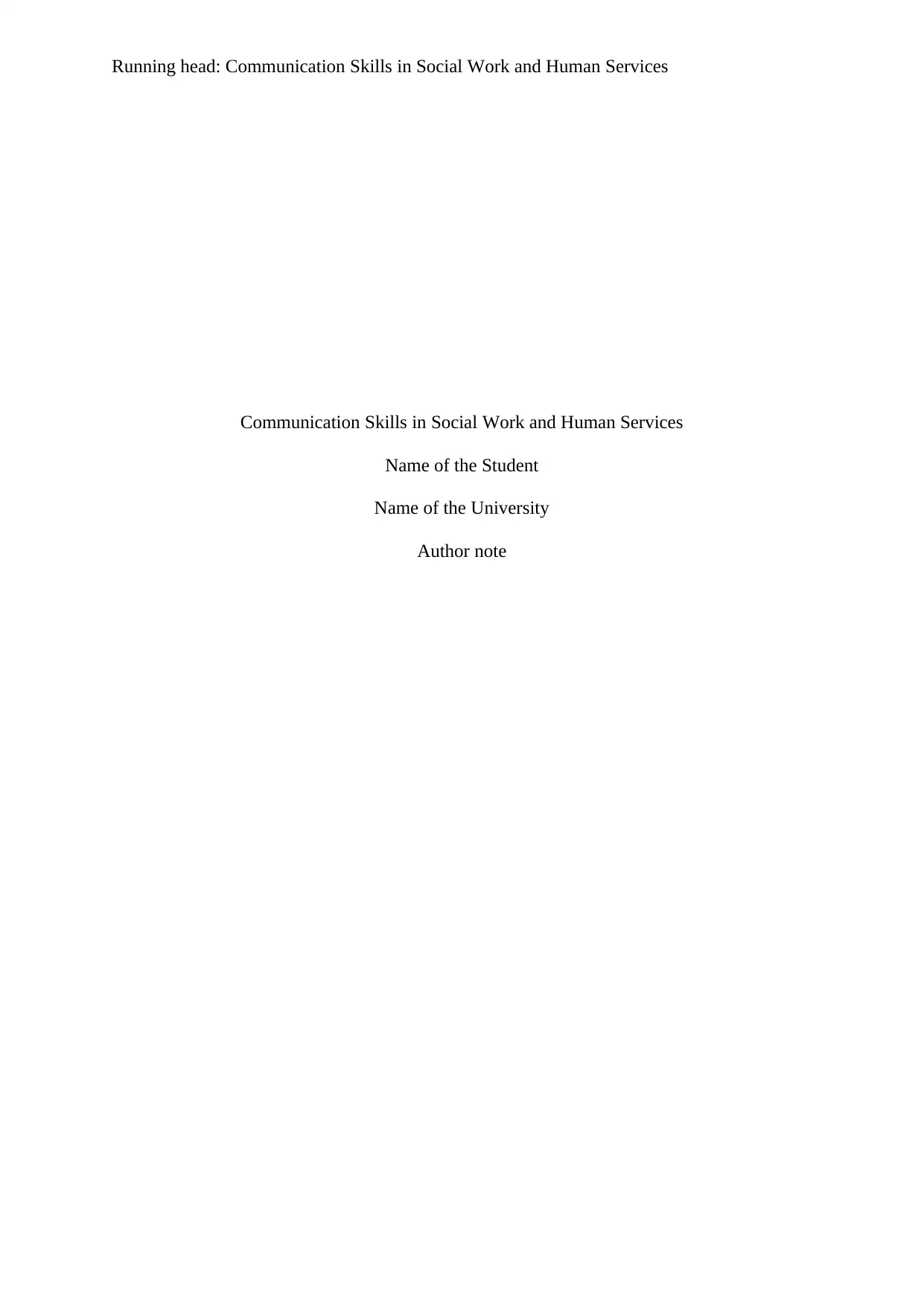
Running head: Communication Skills in Social Work and Human Services
Communication Skills in Social Work and Human Services
Name of the Student
Name of the University
Author note
Communication Skills in Social Work and Human Services
Name of the Student
Name of the University
Author note
Paraphrase This Document
Need a fresh take? Get an instant paraphrase of this document with our AI Paraphraser
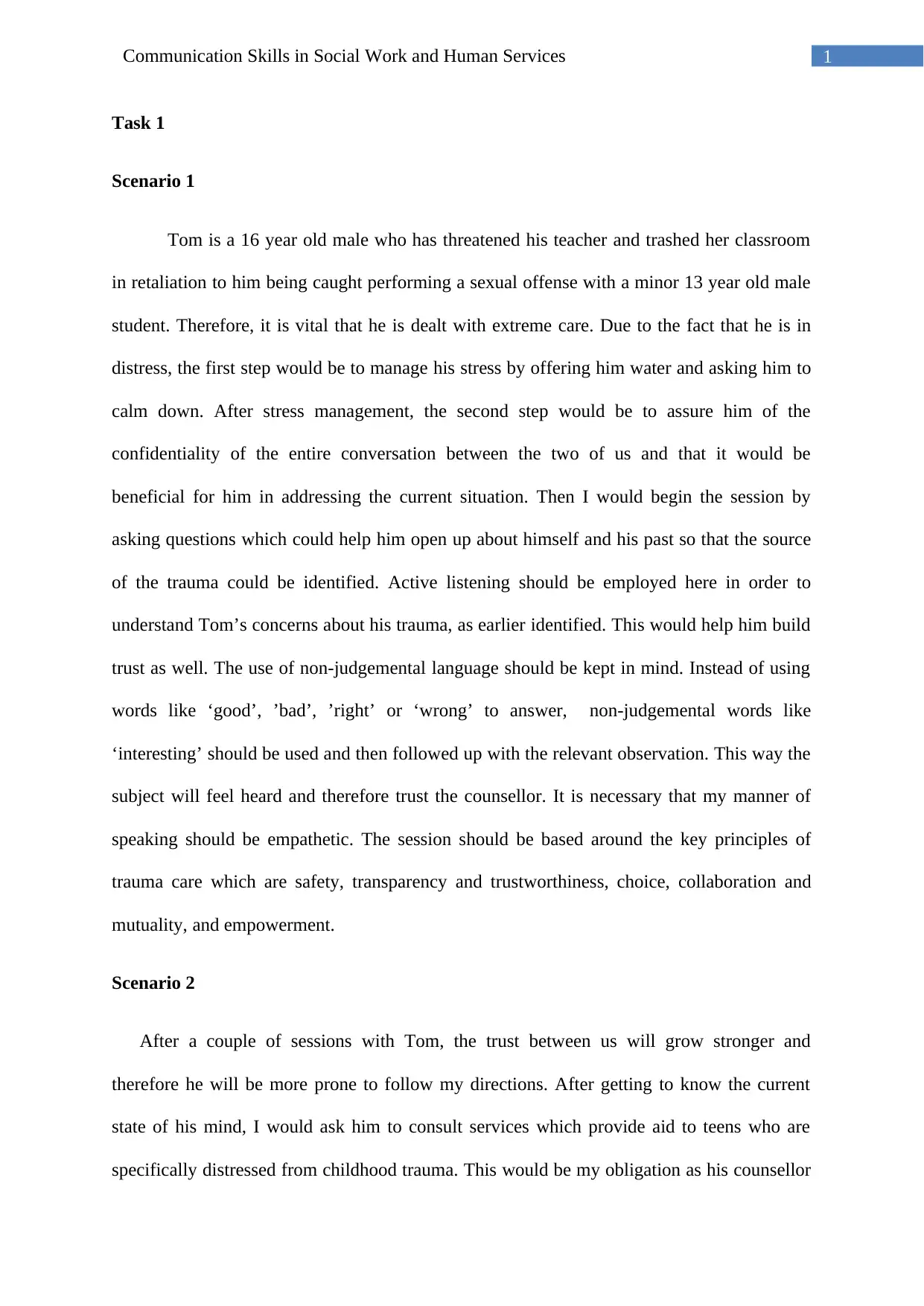
1Communication Skills in Social Work and Human Services
Task 1
Scenario 1
Tom is a 16 year old male who has threatened his teacher and trashed her classroom
in retaliation to him being caught performing a sexual offense with a minor 13 year old male
student. Therefore, it is vital that he is dealt with extreme care. Due to the fact that he is in
distress, the first step would be to manage his stress by offering him water and asking him to
calm down. After stress management, the second step would be to assure him of the
confidentiality of the entire conversation between the two of us and that it would be
beneficial for him in addressing the current situation. Then I would begin the session by
asking questions which could help him open up about himself and his past so that the source
of the trauma could be identified. Active listening should be employed here in order to
understand Tom’s concerns about his trauma, as earlier identified. This would help him build
trust as well. The use of non-judgemental language should be kept in mind. Instead of using
words like ‘good’, ’bad’, ’right’ or ‘wrong’ to answer, non-judgemental words like
‘interesting’ should be used and then followed up with the relevant observation. This way the
subject will feel heard and therefore trust the counsellor. It is necessary that my manner of
speaking should be empathetic. The session should be based around the key principles of
trauma care which are safety, transparency and trustworthiness, choice, collaboration and
mutuality, and empowerment.
Scenario 2
After a couple of sessions with Tom, the trust between us will grow stronger and
therefore he will be more prone to follow my directions. After getting to know the current
state of his mind, I would ask him to consult services which provide aid to teens who are
specifically distressed from childhood trauma. This would be my obligation as his counsellor
Task 1
Scenario 1
Tom is a 16 year old male who has threatened his teacher and trashed her classroom
in retaliation to him being caught performing a sexual offense with a minor 13 year old male
student. Therefore, it is vital that he is dealt with extreme care. Due to the fact that he is in
distress, the first step would be to manage his stress by offering him water and asking him to
calm down. After stress management, the second step would be to assure him of the
confidentiality of the entire conversation between the two of us and that it would be
beneficial for him in addressing the current situation. Then I would begin the session by
asking questions which could help him open up about himself and his past so that the source
of the trauma could be identified. Active listening should be employed here in order to
understand Tom’s concerns about his trauma, as earlier identified. This would help him build
trust as well. The use of non-judgemental language should be kept in mind. Instead of using
words like ‘good’, ’bad’, ’right’ or ‘wrong’ to answer, non-judgemental words like
‘interesting’ should be used and then followed up with the relevant observation. This way the
subject will feel heard and therefore trust the counsellor. It is necessary that my manner of
speaking should be empathetic. The session should be based around the key principles of
trauma care which are safety, transparency and trustworthiness, choice, collaboration and
mutuality, and empowerment.
Scenario 2
After a couple of sessions with Tom, the trust between us will grow stronger and
therefore he will be more prone to follow my directions. After getting to know the current
state of his mind, I would ask him to consult services which provide aid to teens who are
specifically distressed from childhood trauma. This would be my obligation as his counsellor
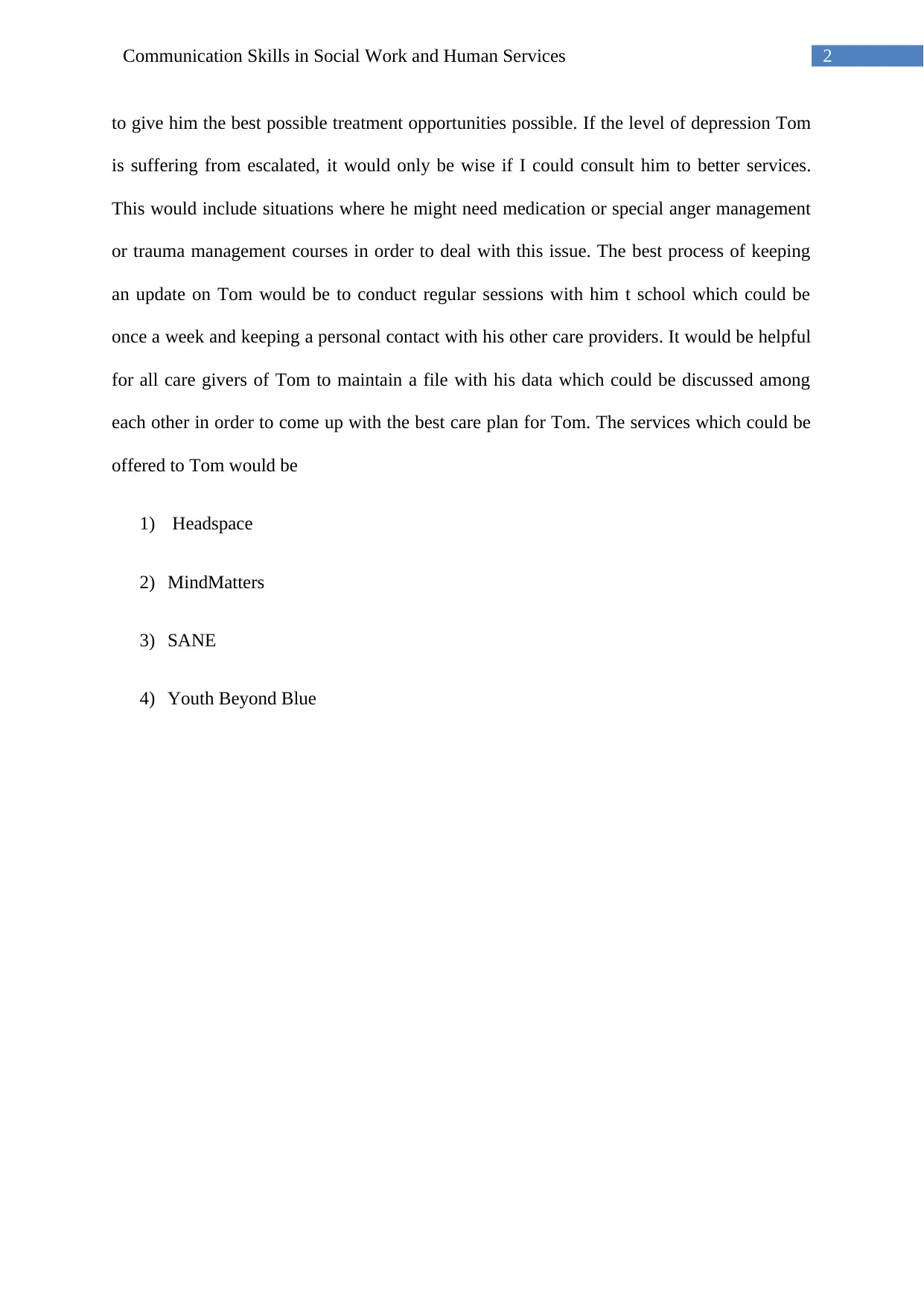
2Communication Skills in Social Work and Human Services
to give him the best possible treatment opportunities possible. If the level of depression Tom
is suffering from escalated, it would only be wise if I could consult him to better services.
This would include situations where he might need medication or special anger management
or trauma management courses in order to deal with this issue. The best process of keeping
an update on Tom would be to conduct regular sessions with him t school which could be
once a week and keeping a personal contact with his other care providers. It would be helpful
for all care givers of Tom to maintain a file with his data which could be discussed among
each other in order to come up with the best care plan for Tom. The services which could be
offered to Tom would be
1) Headspace
2) MindMatters
3) SANE
4) Youth Beyond Blue
to give him the best possible treatment opportunities possible. If the level of depression Tom
is suffering from escalated, it would only be wise if I could consult him to better services.
This would include situations where he might need medication or special anger management
or trauma management courses in order to deal with this issue. The best process of keeping
an update on Tom would be to conduct regular sessions with him t school which could be
once a week and keeping a personal contact with his other care providers. It would be helpful
for all care givers of Tom to maintain a file with his data which could be discussed among
each other in order to come up with the best care plan for Tom. The services which could be
offered to Tom would be
1) Headspace
2) MindMatters
3) SANE
4) Youth Beyond Blue
⊘ This is a preview!⊘
Do you want full access?
Subscribe today to unlock all pages.

Trusted by 1+ million students worldwide
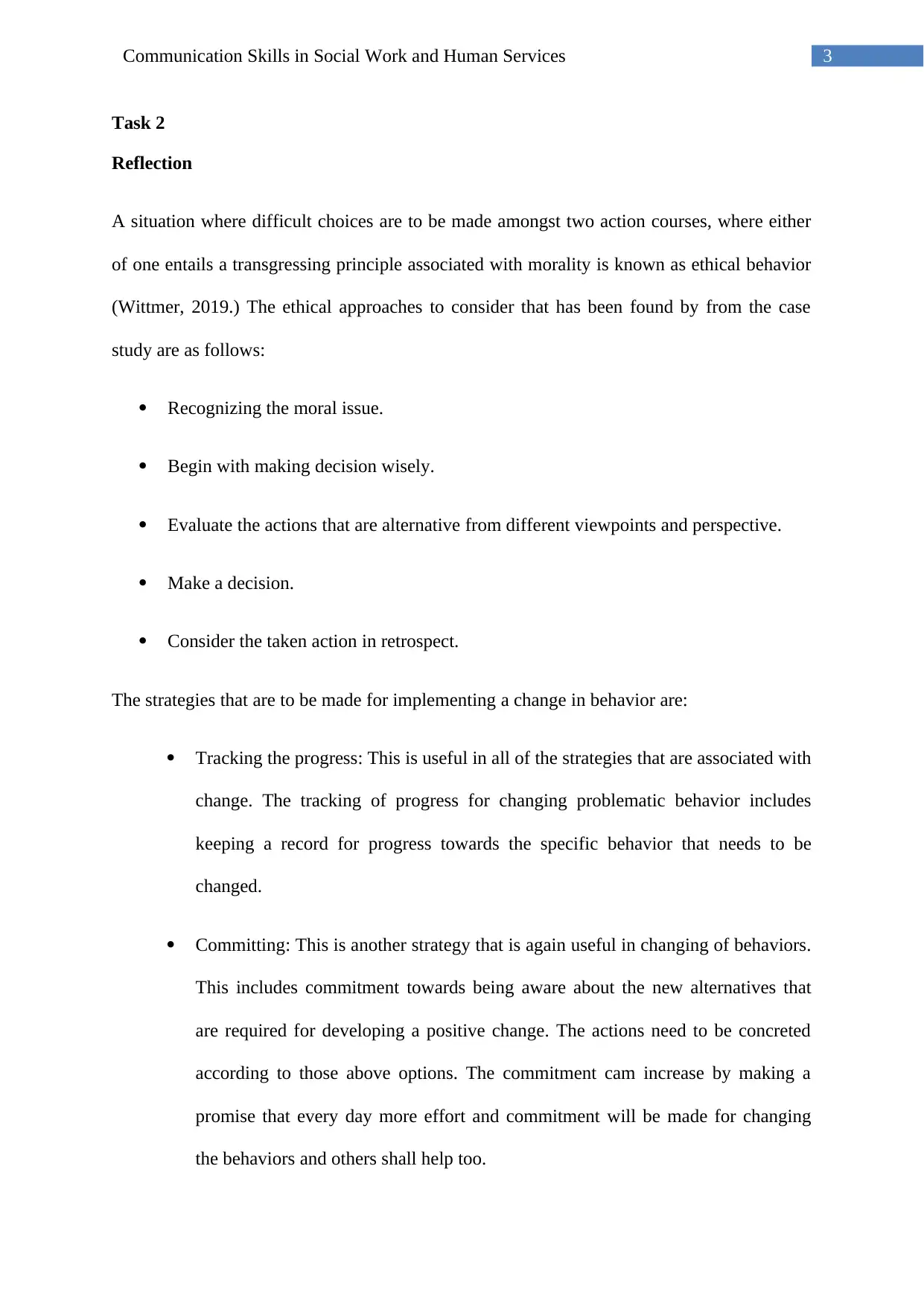
3Communication Skills in Social Work and Human Services
Task 2
Reflection
A situation where difficult choices are to be made amongst two action courses, where either
of one entails a transgressing principle associated with morality is known as ethical behavior
(Wittmer, 2019.) The ethical approaches to consider that has been found by from the case
study are as follows:
Recognizing the moral issue.
Begin with making decision wisely.
Evaluate the actions that are alternative from different viewpoints and perspective.
Make a decision.
Consider the taken action in retrospect.
The strategies that are to be made for implementing a change in behavior are:
Tracking the progress: This is useful in all of the strategies that are associated with
change. The tracking of progress for changing problematic behavior includes
keeping a record for progress towards the specific behavior that needs to be
changed.
Committing: This is another strategy that is again useful in changing of behaviors.
This includes commitment towards being aware about the new alternatives that
are required for developing a positive change. The actions need to be concreted
according to those above options. The commitment cam increase by making a
promise that every day more effort and commitment will be made for changing
the behaviors and others shall help too.
Task 2
Reflection
A situation where difficult choices are to be made amongst two action courses, where either
of one entails a transgressing principle associated with morality is known as ethical behavior
(Wittmer, 2019.) The ethical approaches to consider that has been found by from the case
study are as follows:
Recognizing the moral issue.
Begin with making decision wisely.
Evaluate the actions that are alternative from different viewpoints and perspective.
Make a decision.
Consider the taken action in retrospect.
The strategies that are to be made for implementing a change in behavior are:
Tracking the progress: This is useful in all of the strategies that are associated with
change. The tracking of progress for changing problematic behavior includes
keeping a record for progress towards the specific behavior that needs to be
changed.
Committing: This is another strategy that is again useful in changing of behaviors.
This includes commitment towards being aware about the new alternatives that
are required for developing a positive change. The actions need to be concreted
according to those above options. The commitment cam increase by making a
promise that every day more effort and commitment will be made for changing
the behaviors and others shall help too.
Paraphrase This Document
Need a fresh take? Get an instant paraphrase of this document with our AI Paraphraser
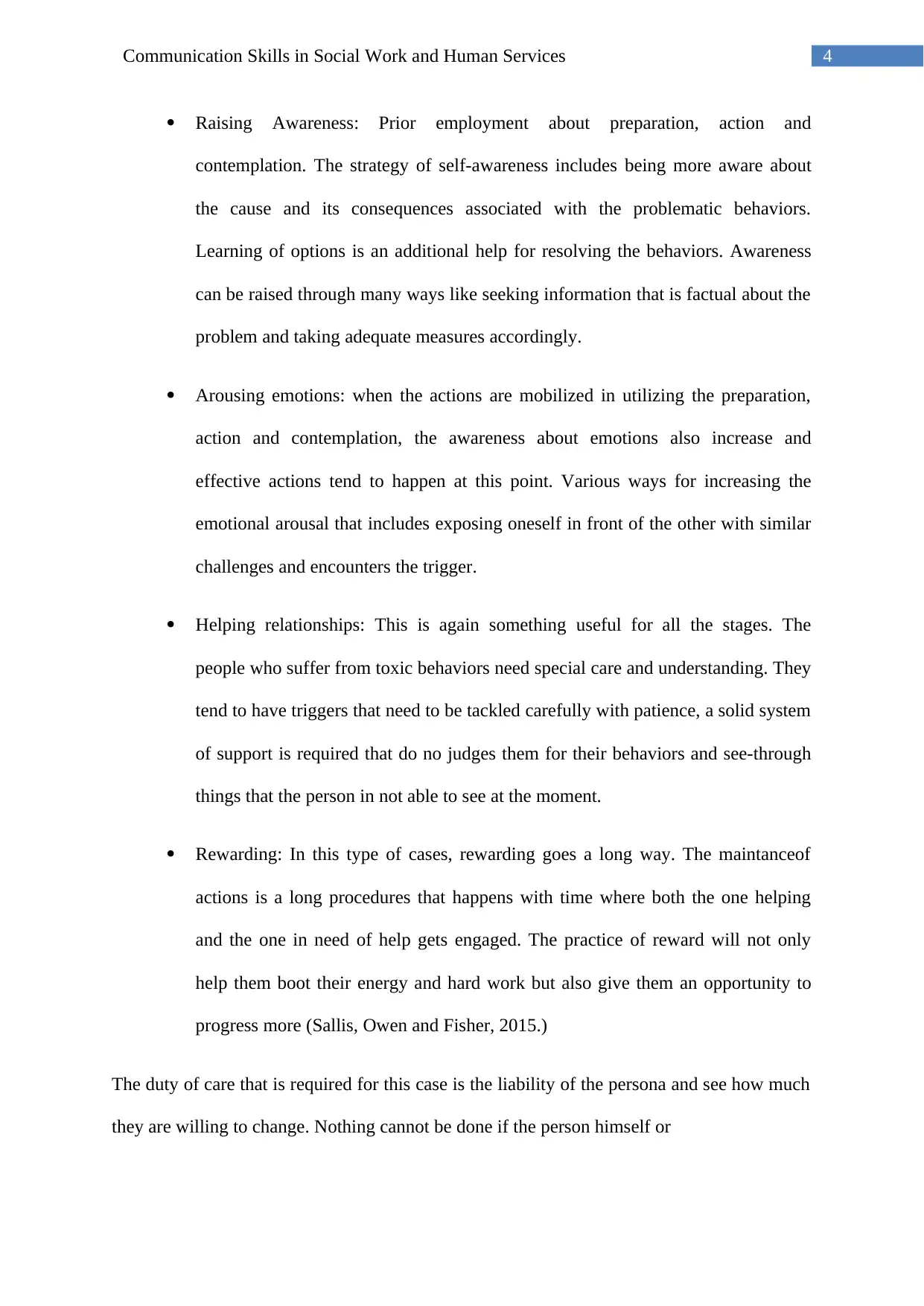
4Communication Skills in Social Work and Human Services
Raising Awareness: Prior employment about preparation, action and
contemplation. The strategy of self-awareness includes being more aware about
the cause and its consequences associated with the problematic behaviors.
Learning of options is an additional help for resolving the behaviors. Awareness
can be raised through many ways like seeking information that is factual about the
problem and taking adequate measures accordingly.
Arousing emotions: when the actions are mobilized in utilizing the preparation,
action and contemplation, the awareness about emotions also increase and
effective actions tend to happen at this point. Various ways for increasing the
emotional arousal that includes exposing oneself in front of the other with similar
challenges and encounters the trigger.
Helping relationships: This is again something useful for all the stages. The
people who suffer from toxic behaviors need special care and understanding. They
tend to have triggers that need to be tackled carefully with patience, a solid system
of support is required that do no judges them for their behaviors and see-through
things that the person in not able to see at the moment.
Rewarding: In this type of cases, rewarding goes a long way. The maintanceof
actions is a long procedures that happens with time where both the one helping
and the one in need of help gets engaged. The practice of reward will not only
help them boot their energy and hard work but also give them an opportunity to
progress more (Sallis, Owen and Fisher, 2015.)
The duty of care that is required for this case is the liability of the persona and see how much
they are willing to change. Nothing cannot be done if the person himself or
Raising Awareness: Prior employment about preparation, action and
contemplation. The strategy of self-awareness includes being more aware about
the cause and its consequences associated with the problematic behaviors.
Learning of options is an additional help for resolving the behaviors. Awareness
can be raised through many ways like seeking information that is factual about the
problem and taking adequate measures accordingly.
Arousing emotions: when the actions are mobilized in utilizing the preparation,
action and contemplation, the awareness about emotions also increase and
effective actions tend to happen at this point. Various ways for increasing the
emotional arousal that includes exposing oneself in front of the other with similar
challenges and encounters the trigger.
Helping relationships: This is again something useful for all the stages. The
people who suffer from toxic behaviors need special care and understanding. They
tend to have triggers that need to be tackled carefully with patience, a solid system
of support is required that do no judges them for their behaviors and see-through
things that the person in not able to see at the moment.
Rewarding: In this type of cases, rewarding goes a long way. The maintanceof
actions is a long procedures that happens with time where both the one helping
and the one in need of help gets engaged. The practice of reward will not only
help them boot their energy and hard work but also give them an opportunity to
progress more (Sallis, Owen and Fisher, 2015.)
The duty of care that is required for this case is the liability of the persona and see how much
they are willing to change. Nothing cannot be done if the person himself or
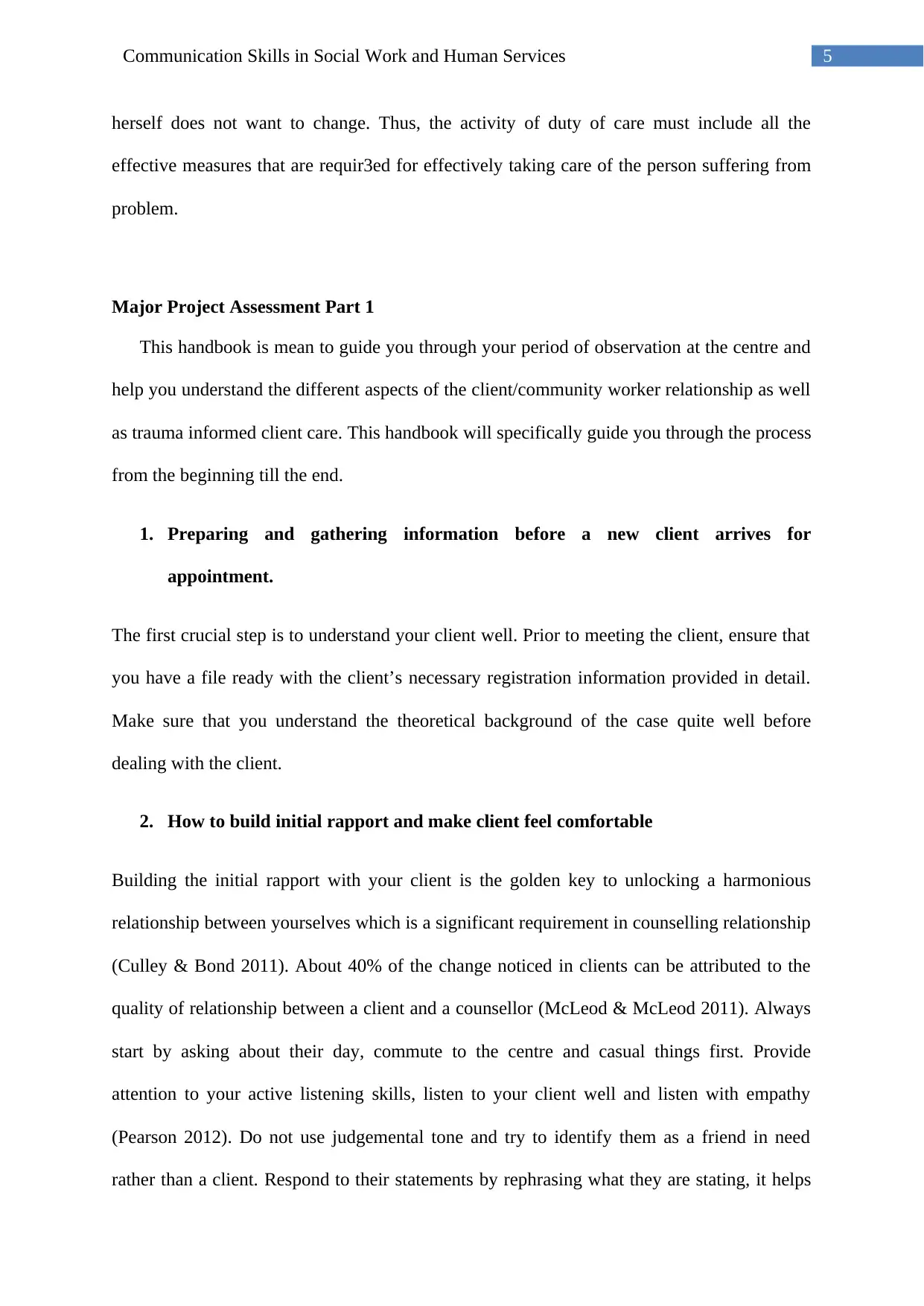
5Communication Skills in Social Work and Human Services
herself does not want to change. Thus, the activity of duty of care must include all the
effective measures that are requir3ed for effectively taking care of the person suffering from
problem.
Major Project Assessment Part 1
This handbook is mean to guide you through your period of observation at the centre and
help you understand the different aspects of the client/community worker relationship as well
as trauma informed client care. This handbook will specifically guide you through the process
from the beginning till the end.
1. Preparing and gathering information before a new client arrives for
appointment.
The first crucial step is to understand your client well. Prior to meeting the client, ensure that
you have a file ready with the client’s necessary registration information provided in detail.
Make sure that you understand the theoretical background of the case quite well before
dealing with the client.
2. How to build initial rapport and make client feel comfortable
Building the initial rapport with your client is the golden key to unlocking a harmonious
relationship between yourselves which is a significant requirement in counselling relationship
(Culley & Bond 2011). About 40% of the change noticed in clients can be attributed to the
quality of relationship between a client and a counsellor (McLeod & McLeod 2011). Always
start by asking about their day, commute to the centre and casual things first. Provide
attention to your active listening skills, listen to your client well and listen with empathy
(Pearson 2012). Do not use judgemental tone and try to identify them as a friend in need
rather than a client. Respond to their statements by rephrasing what they are stating, it helps
herself does not want to change. Thus, the activity of duty of care must include all the
effective measures that are requir3ed for effectively taking care of the person suffering from
problem.
Major Project Assessment Part 1
This handbook is mean to guide you through your period of observation at the centre and
help you understand the different aspects of the client/community worker relationship as well
as trauma informed client care. This handbook will specifically guide you through the process
from the beginning till the end.
1. Preparing and gathering information before a new client arrives for
appointment.
The first crucial step is to understand your client well. Prior to meeting the client, ensure that
you have a file ready with the client’s necessary registration information provided in detail.
Make sure that you understand the theoretical background of the case quite well before
dealing with the client.
2. How to build initial rapport and make client feel comfortable
Building the initial rapport with your client is the golden key to unlocking a harmonious
relationship between yourselves which is a significant requirement in counselling relationship
(Culley & Bond 2011). About 40% of the change noticed in clients can be attributed to the
quality of relationship between a client and a counsellor (McLeod & McLeod 2011). Always
start by asking about their day, commute to the centre and casual things first. Provide
attention to your active listening skills, listen to your client well and listen with empathy
(Pearson 2012). Do not use judgemental tone and try to identify them as a friend in need
rather than a client. Respond to their statements by rephrasing what they are stating, it helps
⊘ This is a preview!⊘
Do you want full access?
Subscribe today to unlock all pages.

Trusted by 1+ million students worldwide
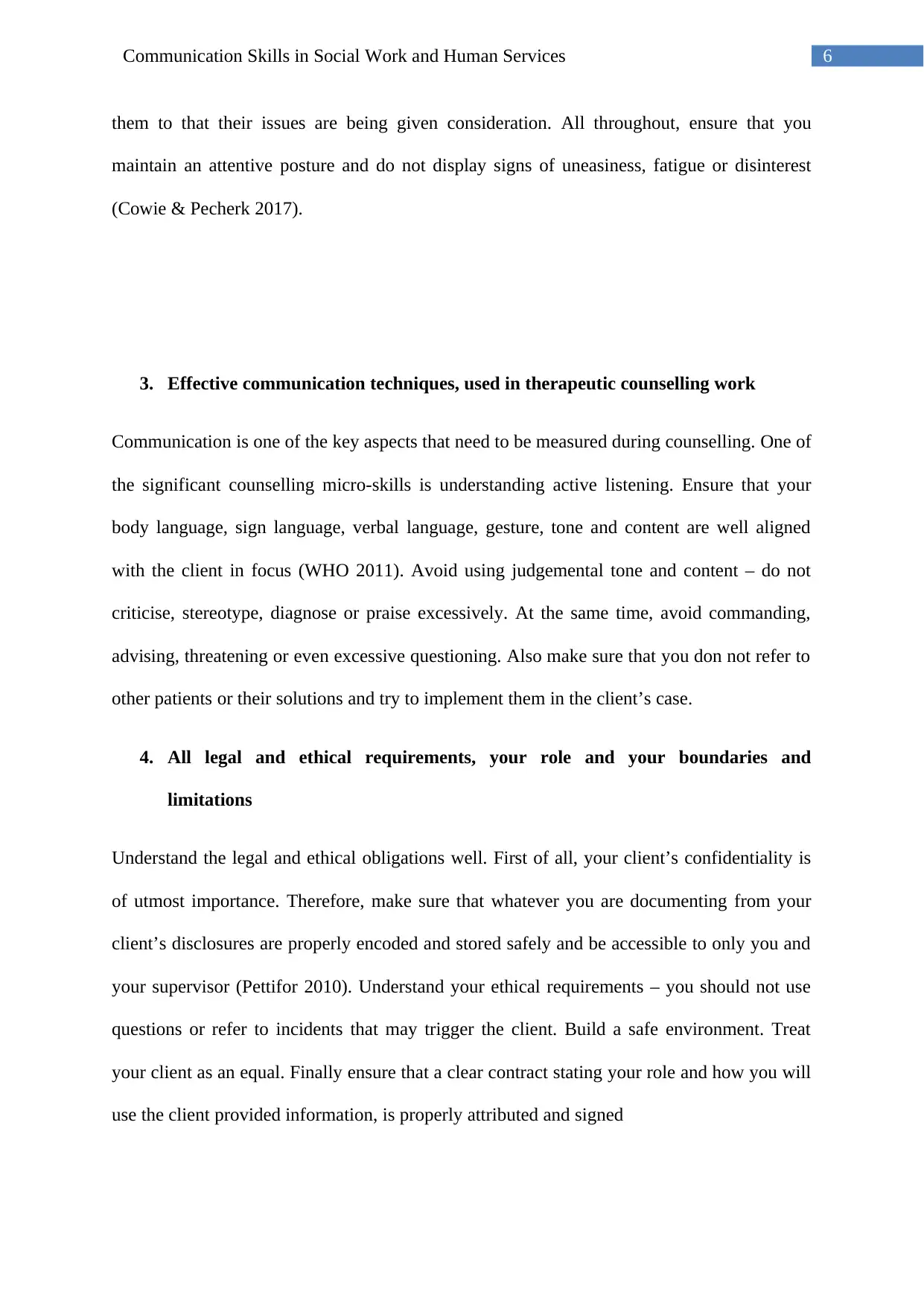
6Communication Skills in Social Work and Human Services
them to that their issues are being given consideration. All throughout, ensure that you
maintain an attentive posture and do not display signs of uneasiness, fatigue or disinterest
(Cowie & Pecherk 2017).
3. Effective communication techniques, used in therapeutic counselling work
Communication is one of the key aspects that need to be measured during counselling. One of
the significant counselling micro-skills is understanding active listening. Ensure that your
body language, sign language, verbal language, gesture, tone and content are well aligned
with the client in focus (WHO 2011). Avoid using judgemental tone and content – do not
criticise, stereotype, diagnose or praise excessively. At the same time, avoid commanding,
advising, threatening or even excessive questioning. Also make sure that you don not refer to
other patients or their solutions and try to implement them in the client’s case.
4. All legal and ethical requirements, your role and your boundaries and
limitations
Understand the legal and ethical obligations well. First of all, your client’s confidentiality is
of utmost importance. Therefore, make sure that whatever you are documenting from your
client’s disclosures are properly encoded and stored safely and be accessible to only you and
your supervisor (Pettifor 2010). Understand your ethical requirements – you should not use
questions or refer to incidents that may trigger the client. Build a safe environment. Treat
your client as an equal. Finally ensure that a clear contract stating your role and how you will
use the client provided information, is properly attributed and signed
them to that their issues are being given consideration. All throughout, ensure that you
maintain an attentive posture and do not display signs of uneasiness, fatigue or disinterest
(Cowie & Pecherk 2017).
3. Effective communication techniques, used in therapeutic counselling work
Communication is one of the key aspects that need to be measured during counselling. One of
the significant counselling micro-skills is understanding active listening. Ensure that your
body language, sign language, verbal language, gesture, tone and content are well aligned
with the client in focus (WHO 2011). Avoid using judgemental tone and content – do not
criticise, stereotype, diagnose or praise excessively. At the same time, avoid commanding,
advising, threatening or even excessive questioning. Also make sure that you don not refer to
other patients or their solutions and try to implement them in the client’s case.
4. All legal and ethical requirements, your role and your boundaries and
limitations
Understand the legal and ethical obligations well. First of all, your client’s confidentiality is
of utmost importance. Therefore, make sure that whatever you are documenting from your
client’s disclosures are properly encoded and stored safely and be accessible to only you and
your supervisor (Pettifor 2010). Understand your ethical requirements – you should not use
questions or refer to incidents that may trigger the client. Build a safe environment. Treat
your client as an equal. Finally ensure that a clear contract stating your role and how you will
use the client provided information, is properly attributed and signed
Paraphrase This Document
Need a fresh take? Get an instant paraphrase of this document with our AI Paraphraser
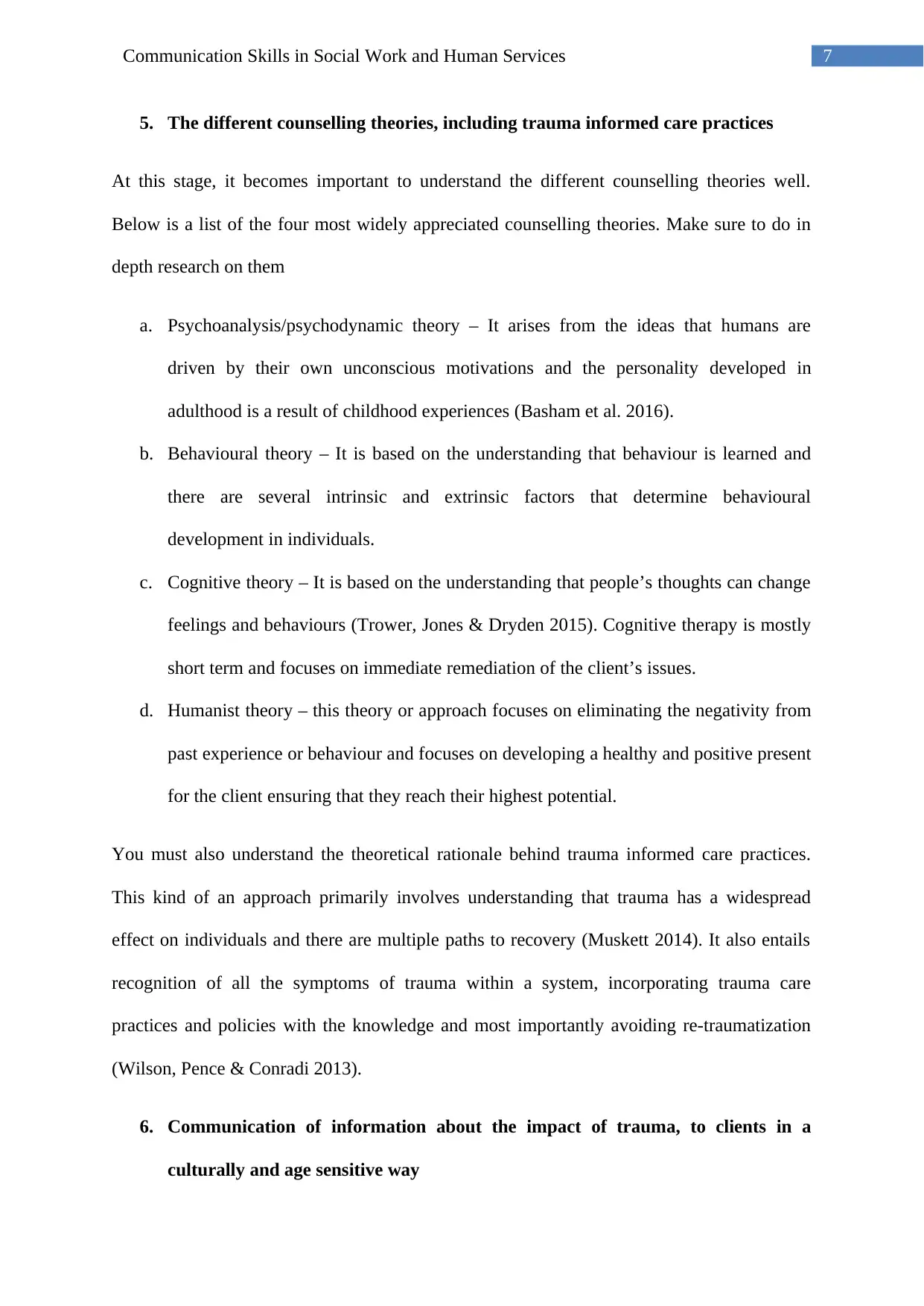
7Communication Skills in Social Work and Human Services
5. The different counselling theories, including trauma informed care practices
At this stage, it becomes important to understand the different counselling theories well.
Below is a list of the four most widely appreciated counselling theories. Make sure to do in
depth research on them
a. Psychoanalysis/psychodynamic theory – It arises from the ideas that humans are
driven by their own unconscious motivations and the personality developed in
adulthood is a result of childhood experiences (Basham et al. 2016).
b. Behavioural theory – It is based on the understanding that behaviour is learned and
there are several intrinsic and extrinsic factors that determine behavioural
development in individuals.
c. Cognitive theory – It is based on the understanding that people’s thoughts can change
feelings and behaviours (Trower, Jones & Dryden 2015). Cognitive therapy is mostly
short term and focuses on immediate remediation of the client’s issues.
d. Humanist theory – this theory or approach focuses on eliminating the negativity from
past experience or behaviour and focuses on developing a healthy and positive present
for the client ensuring that they reach their highest potential.
You must also understand the theoretical rationale behind trauma informed care practices.
This kind of an approach primarily involves understanding that trauma has a widespread
effect on individuals and there are multiple paths to recovery (Muskett 2014). It also entails
recognition of all the symptoms of trauma within a system, incorporating trauma care
practices and policies with the knowledge and most importantly avoiding re-traumatization
(Wilson, Pence & Conradi 2013).
6. Communication of information about the impact of trauma, to clients in a
culturally and age sensitive way
5. The different counselling theories, including trauma informed care practices
At this stage, it becomes important to understand the different counselling theories well.
Below is a list of the four most widely appreciated counselling theories. Make sure to do in
depth research on them
a. Psychoanalysis/psychodynamic theory – It arises from the ideas that humans are
driven by their own unconscious motivations and the personality developed in
adulthood is a result of childhood experiences (Basham et al. 2016).
b. Behavioural theory – It is based on the understanding that behaviour is learned and
there are several intrinsic and extrinsic factors that determine behavioural
development in individuals.
c. Cognitive theory – It is based on the understanding that people’s thoughts can change
feelings and behaviours (Trower, Jones & Dryden 2015). Cognitive therapy is mostly
short term and focuses on immediate remediation of the client’s issues.
d. Humanist theory – this theory or approach focuses on eliminating the negativity from
past experience or behaviour and focuses on developing a healthy and positive present
for the client ensuring that they reach their highest potential.
You must also understand the theoretical rationale behind trauma informed care practices.
This kind of an approach primarily involves understanding that trauma has a widespread
effect on individuals and there are multiple paths to recovery (Muskett 2014). It also entails
recognition of all the symptoms of trauma within a system, incorporating trauma care
practices and policies with the knowledge and most importantly avoiding re-traumatization
(Wilson, Pence & Conradi 2013).
6. Communication of information about the impact of trauma, to clients in a
culturally and age sensitive way
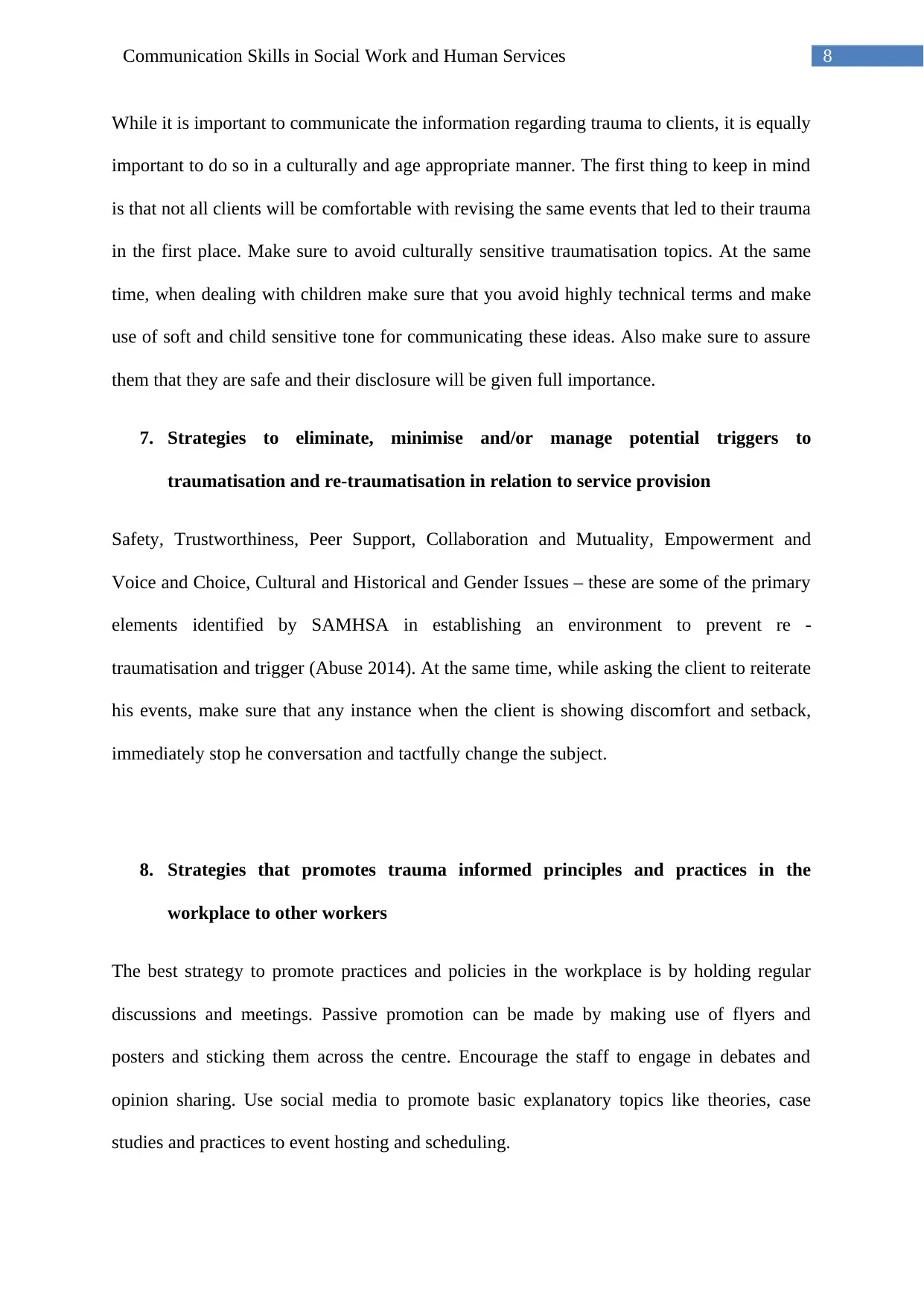
8Communication Skills in Social Work and Human Services
While it is important to communicate the information regarding trauma to clients, it is equally
important to do so in a culturally and age appropriate manner. The first thing to keep in mind
is that not all clients will be comfortable with revising the same events that led to their trauma
in the first place. Make sure to avoid culturally sensitive traumatisation topics. At the same
time, when dealing with children make sure that you avoid highly technical terms and make
use of soft and child sensitive tone for communicating these ideas. Also make sure to assure
them that they are safe and their disclosure will be given full importance.
7. Strategies to eliminate, minimise and/or manage potential triggers to
traumatisation and re-traumatisation in relation to service provision
Safety, Trustworthiness, Peer Support, Collaboration and Mutuality, Empowerment and
Voice and Choice, Cultural and Historical and Gender Issues – these are some of the primary
elements identified by SAMHSA in establishing an environment to prevent re -
traumatisation and trigger (Abuse 2014). At the same time, while asking the client to reiterate
his events, make sure that any instance when the client is showing discomfort and setback,
immediately stop he conversation and tactfully change the subject.
8. Strategies that promotes trauma informed principles and practices in the
workplace to other workers
The best strategy to promote practices and policies in the workplace is by holding regular
discussions and meetings. Passive promotion can be made by making use of flyers and
posters and sticking them across the centre. Encourage the staff to engage in debates and
opinion sharing. Use social media to promote basic explanatory topics like theories, case
studies and practices to event hosting and scheduling.
While it is important to communicate the information regarding trauma to clients, it is equally
important to do so in a culturally and age appropriate manner. The first thing to keep in mind
is that not all clients will be comfortable with revising the same events that led to their trauma
in the first place. Make sure to avoid culturally sensitive traumatisation topics. At the same
time, when dealing with children make sure that you avoid highly technical terms and make
use of soft and child sensitive tone for communicating these ideas. Also make sure to assure
them that they are safe and their disclosure will be given full importance.
7. Strategies to eliminate, minimise and/or manage potential triggers to
traumatisation and re-traumatisation in relation to service provision
Safety, Trustworthiness, Peer Support, Collaboration and Mutuality, Empowerment and
Voice and Choice, Cultural and Historical and Gender Issues – these are some of the primary
elements identified by SAMHSA in establishing an environment to prevent re -
traumatisation and trigger (Abuse 2014). At the same time, while asking the client to reiterate
his events, make sure that any instance when the client is showing discomfort and setback,
immediately stop he conversation and tactfully change the subject.
8. Strategies that promotes trauma informed principles and practices in the
workplace to other workers
The best strategy to promote practices and policies in the workplace is by holding regular
discussions and meetings. Passive promotion can be made by making use of flyers and
posters and sticking them across the centre. Encourage the staff to engage in debates and
opinion sharing. Use social media to promote basic explanatory topics like theories, case
studies and practices to event hosting and scheduling.
⊘ This is a preview!⊘
Do you want full access?
Subscribe today to unlock all pages.

Trusted by 1+ million students worldwide
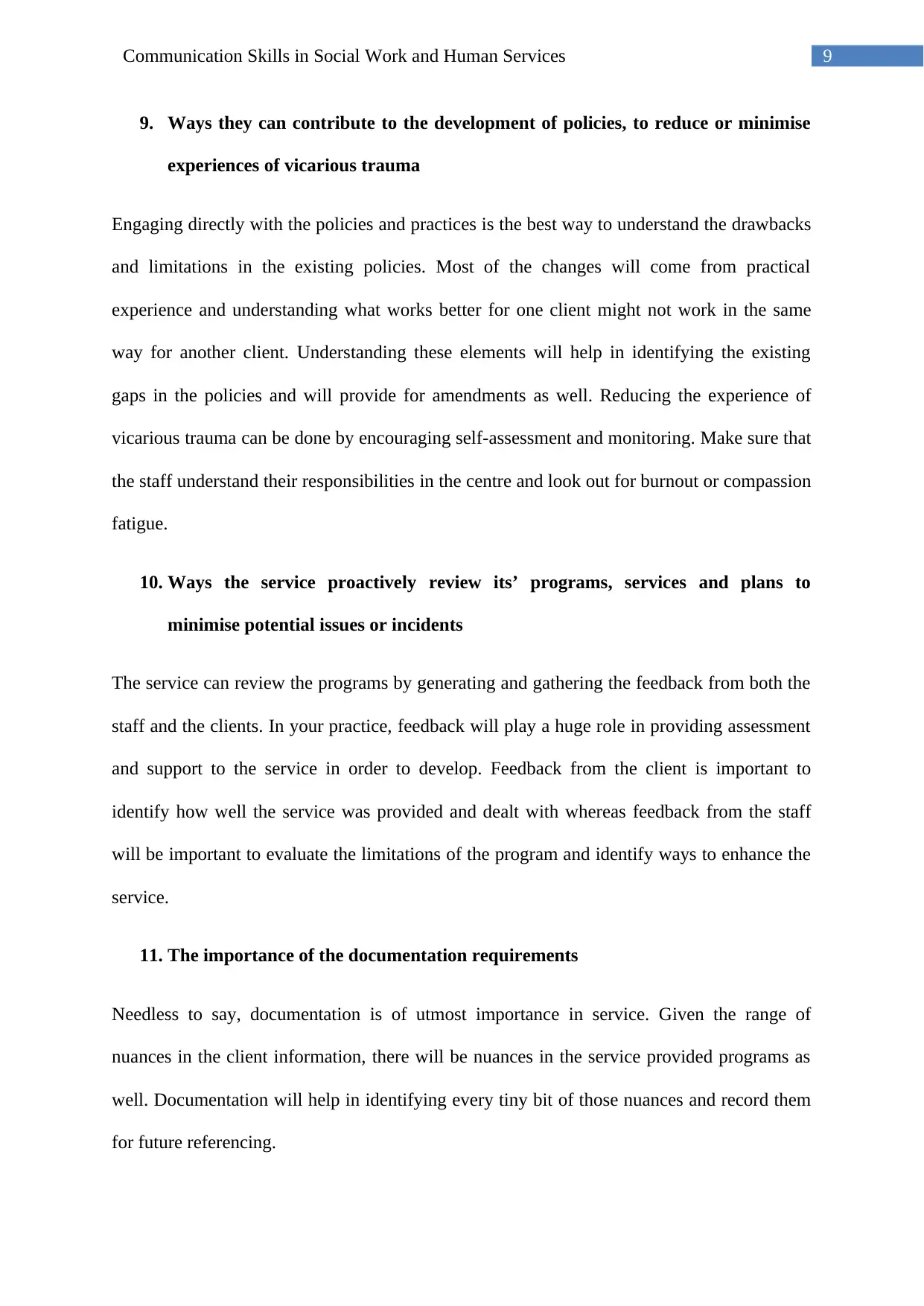
9Communication Skills in Social Work and Human Services
9. Ways they can contribute to the development of policies, to reduce or minimise
experiences of vicarious trauma
Engaging directly with the policies and practices is the best way to understand the drawbacks
and limitations in the existing policies. Most of the changes will come from practical
experience and understanding what works better for one client might not work in the same
way for another client. Understanding these elements will help in identifying the existing
gaps in the policies and will provide for amendments as well. Reducing the experience of
vicarious trauma can be done by encouraging self-assessment and monitoring. Make sure that
the staff understand their responsibilities in the centre and look out for burnout or compassion
fatigue.
10. Ways the service proactively review its’ programs, services and plans to
minimise potential issues or incidents
The service can review the programs by generating and gathering the feedback from both the
staff and the clients. In your practice, feedback will play a huge role in providing assessment
and support to the service in order to develop. Feedback from the client is important to
identify how well the service was provided and dealt with whereas feedback from the staff
will be important to evaluate the limitations of the program and identify ways to enhance the
service.
11. The importance of the documentation requirements
Needless to say, documentation is of utmost importance in service. Given the range of
nuances in the client information, there will be nuances in the service provided programs as
well. Documentation will help in identifying every tiny bit of those nuances and record them
for future referencing.
9. Ways they can contribute to the development of policies, to reduce or minimise
experiences of vicarious trauma
Engaging directly with the policies and practices is the best way to understand the drawbacks
and limitations in the existing policies. Most of the changes will come from practical
experience and understanding what works better for one client might not work in the same
way for another client. Understanding these elements will help in identifying the existing
gaps in the policies and will provide for amendments as well. Reducing the experience of
vicarious trauma can be done by encouraging self-assessment and monitoring. Make sure that
the staff understand their responsibilities in the centre and look out for burnout or compassion
fatigue.
10. Ways the service proactively review its’ programs, services and plans to
minimise potential issues or incidents
The service can review the programs by generating and gathering the feedback from both the
staff and the clients. In your practice, feedback will play a huge role in providing assessment
and support to the service in order to develop. Feedback from the client is important to
identify how well the service was provided and dealt with whereas feedback from the staff
will be important to evaluate the limitations of the program and identify ways to enhance the
service.
11. The importance of the documentation requirements
Needless to say, documentation is of utmost importance in service. Given the range of
nuances in the client information, there will be nuances in the service provided programs as
well. Documentation will help in identifying every tiny bit of those nuances and record them
for future referencing.
Paraphrase This Document
Need a fresh take? Get an instant paraphrase of this document with our AI Paraphraser
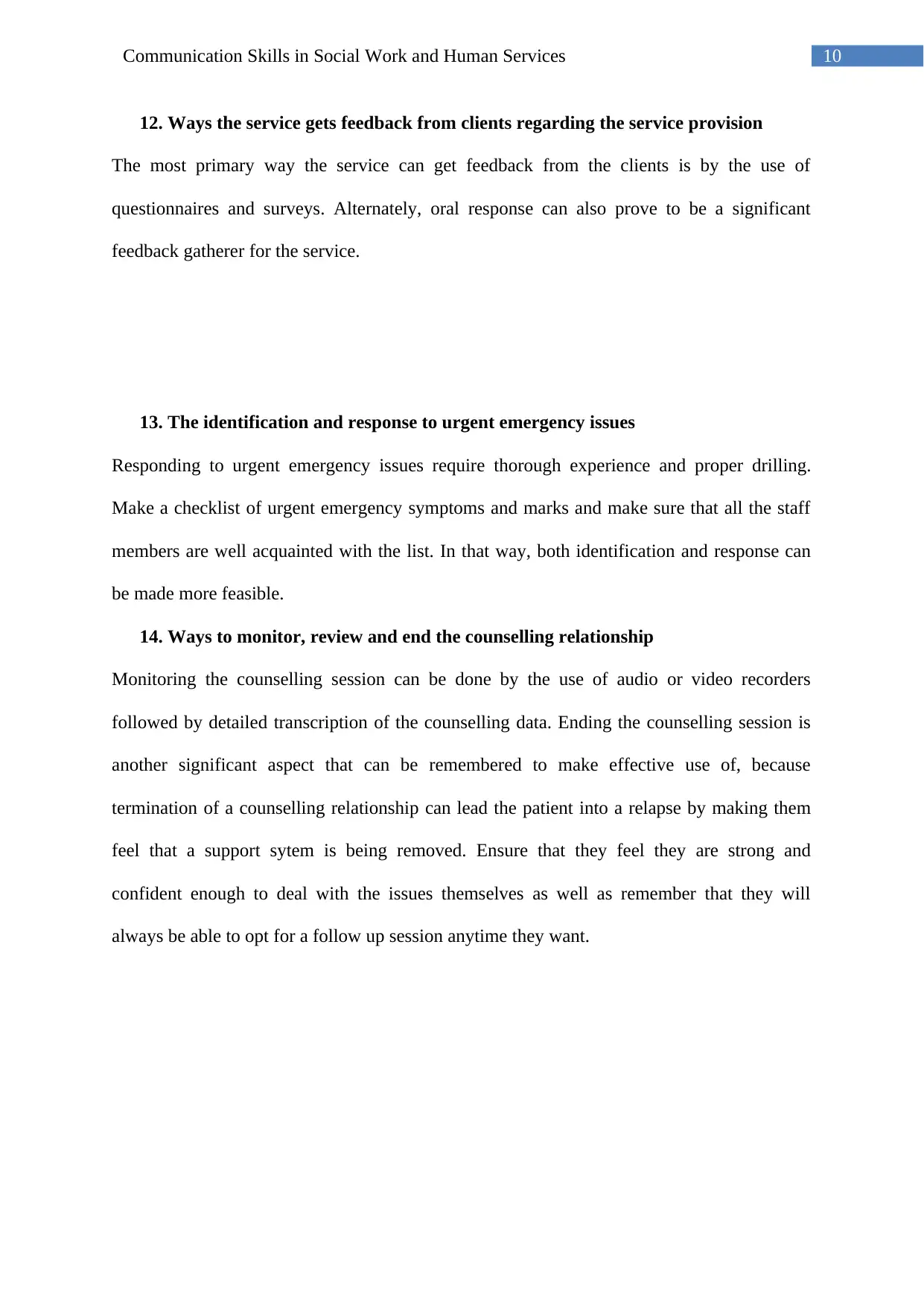
10Communication Skills in Social Work and Human Services
12. Ways the service gets feedback from clients regarding the service provision
The most primary way the service can get feedback from the clients is by the use of
questionnaires and surveys. Alternately, oral response can also prove to be a significant
feedback gatherer for the service.
13. The identification and response to urgent emergency issues
Responding to urgent emergency issues require thorough experience and proper drilling.
Make a checklist of urgent emergency symptoms and marks and make sure that all the staff
members are well acquainted with the list. In that way, both identification and response can
be made more feasible.
14. Ways to monitor, review and end the counselling relationship
Monitoring the counselling session can be done by the use of audio or video recorders
followed by detailed transcription of the counselling data. Ending the counselling session is
another significant aspect that can be remembered to make effective use of, because
termination of a counselling relationship can lead the patient into a relapse by making them
feel that a support sytem is being removed. Ensure that they feel they are strong and
confident enough to deal with the issues themselves as well as remember that they will
always be able to opt for a follow up session anytime they want.
12. Ways the service gets feedback from clients regarding the service provision
The most primary way the service can get feedback from the clients is by the use of
questionnaires and surveys. Alternately, oral response can also prove to be a significant
feedback gatherer for the service.
13. The identification and response to urgent emergency issues
Responding to urgent emergency issues require thorough experience and proper drilling.
Make a checklist of urgent emergency symptoms and marks and make sure that all the staff
members are well acquainted with the list. In that way, both identification and response can
be made more feasible.
14. Ways to monitor, review and end the counselling relationship
Monitoring the counselling session can be done by the use of audio or video recorders
followed by detailed transcription of the counselling data. Ending the counselling session is
another significant aspect that can be remembered to make effective use of, because
termination of a counselling relationship can lead the patient into a relapse by making them
feel that a support sytem is being removed. Ensure that they feel they are strong and
confident enough to deal with the issues themselves as well as remember that they will
always be able to opt for a follow up session anytime they want.
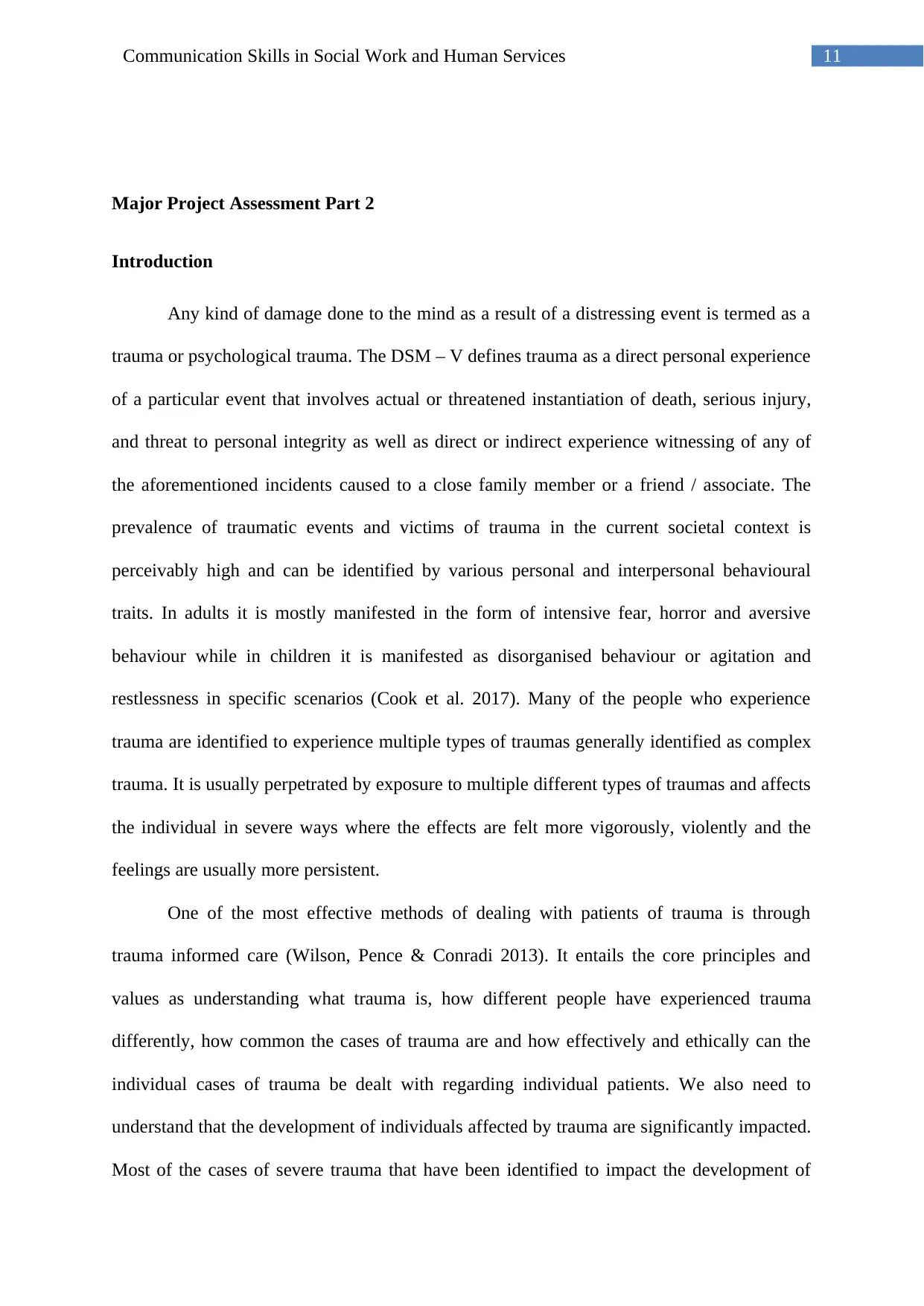
11Communication Skills in Social Work and Human Services
Major Project Assessment Part 2
Introduction
Any kind of damage done to the mind as a result of a distressing event is termed as a
trauma or psychological trauma. The DSM – V defines trauma as a direct personal experience
of a particular event that involves actual or threatened instantiation of death, serious injury,
and threat to personal integrity as well as direct or indirect experience witnessing of any of
the aforementioned incidents caused to a close family member or a friend / associate. The
prevalence of traumatic events and victims of trauma in the current societal context is
perceivably high and can be identified by various personal and interpersonal behavioural
traits. In adults it is mostly manifested in the form of intensive fear, horror and aversive
behaviour while in children it is manifested as disorganised behaviour or agitation and
restlessness in specific scenarios (Cook et al. 2017). Many of the people who experience
trauma are identified to experience multiple types of traumas generally identified as complex
trauma. It is usually perpetrated by exposure to multiple different types of traumas and affects
the individual in severe ways where the effects are felt more vigorously, violently and the
feelings are usually more persistent.
One of the most effective methods of dealing with patients of trauma is through
trauma informed care (Wilson, Pence & Conradi 2013). It entails the core principles and
values as understanding what trauma is, how different people have experienced trauma
differently, how common the cases of trauma are and how effectively and ethically can the
individual cases of trauma be dealt with regarding individual patients. We also need to
understand that the development of individuals affected by trauma are significantly impacted.
Most of the cases of severe trauma that have been identified to impact the development of
Major Project Assessment Part 2
Introduction
Any kind of damage done to the mind as a result of a distressing event is termed as a
trauma or psychological trauma. The DSM – V defines trauma as a direct personal experience
of a particular event that involves actual or threatened instantiation of death, serious injury,
and threat to personal integrity as well as direct or indirect experience witnessing of any of
the aforementioned incidents caused to a close family member or a friend / associate. The
prevalence of traumatic events and victims of trauma in the current societal context is
perceivably high and can be identified by various personal and interpersonal behavioural
traits. In adults it is mostly manifested in the form of intensive fear, horror and aversive
behaviour while in children it is manifested as disorganised behaviour or agitation and
restlessness in specific scenarios (Cook et al. 2017). Many of the people who experience
trauma are identified to experience multiple types of traumas generally identified as complex
trauma. It is usually perpetrated by exposure to multiple different types of traumas and affects
the individual in severe ways where the effects are felt more vigorously, violently and the
feelings are usually more persistent.
One of the most effective methods of dealing with patients of trauma is through
trauma informed care (Wilson, Pence & Conradi 2013). It entails the core principles and
values as understanding what trauma is, how different people have experienced trauma
differently, how common the cases of trauma are and how effectively and ethically can the
individual cases of trauma be dealt with regarding individual patients. We also need to
understand that the development of individuals affected by trauma are significantly impacted.
Most of the cases of severe trauma that have been identified to impact the development of
⊘ This is a preview!⊘
Do you want full access?
Subscribe today to unlock all pages.

Trusted by 1+ million students worldwide
1 out of 21
Related Documents
Your All-in-One AI-Powered Toolkit for Academic Success.
+13062052269
info@desklib.com
Available 24*7 on WhatsApp / Email
![[object Object]](/_next/static/media/star-bottom.7253800d.svg)
Unlock your academic potential
Copyright © 2020–2025 A2Z Services. All Rights Reserved. Developed and managed by ZUCOL.





